Being sustainable is a disease! It spreads. No cure for it, before you know it, you're looking at that broken pair of jandals (slops) and wondering what you can do with it before chucking it out. The simple act of throwing things into the garbage is fraught with conscience. And then one takes on more and more challenges. At some point though, you have to sit back and evaluate how much energy you have left and is it all sustainable?
Yesterday, our friend dropped off our firewood for winter. At the flick of a lever in his truck cab, they came thundering down onto a seemingly enormous pile of work! He casually asked why he hadn't seen us at the morning bee keeping workshop. Ah, because we decided against it, after having attended the first. It seemed so conventional. There was talk of all the chemicals one has to use to stop the verroa mite infestation, and then the foul brood infestation. And so much intervention that it seemd like a full time job! And already having several full time jobs, we decided that bee-keeping was just not sustainable for us at the moment. Maybe later! Besides, we don't seem to have a problem with a lack of bees in our garden at the moment. There is enough biodiversity to attract all sorts of little fliers and crawlers.
And we managed to stack 2 and a half cubic metres of firewood before the rain came down.
 |
I spied this wonderful pollen collector on a Jerusalem artichoke flower. Not
sure quite what species it is, seemed much bigger than the average bee. |
And of course, part of the disease of sustainable living, is using up your produce. A lot of our produce this year is not the best looking due to the weather (it continues to rain even as I blog), so giving away "munted" produce always feels stink. So our kitchen always seems to have excess produce waiting to be processed and the fruit fly has become a household pet. Droves of the wee buggers.
Yesterday, we picked a basketful of small yellow peaches (may stew them), curly tailed Zuchini Ramicante, apples, strawberries (yes, it is Autumn) and I scrounged up some small potatoes and Jerusalem artichokes which we baked for lunch. The lunch felt all the more delicious as the potatoes had "accidentally" grown from some rotting ones I had thrown out beside the pathway. The smell have been awful for a week or so, and then some potato vines had grown, I was amused to see the resilience, so left them till yesterday when I pulled them up to clean up and found a small basinful of beautiful potatoes. The Jerusalem artichokes had also been scrounged accidentally when I pulled up some rogue plants, to find some tubers clinging to the roots. Isn't Nature wonderful?
 |
| Buncha bananas ripening up in the shed |
I keep checking up on our bananas, ever so keen for the sweet, creamy flesh but alas, it's been 3 weeks and I wait still...... slowly they begin to turn a shade of sunshine. But to distract us for a wee while, the joy of discovering that feijoa season is upon us. Not prolifically, like last season, but just gentey. We have just started to collect them (feijoas are traditionally not picked but collected as they drop to the ground) and squeal with glee as we scoop them out by the teaspoonful and taste the sweet tartness that is feijoa. Last year, mid-season, we were so over feijoas! I had bottled heaps of pureed feijoa, frozen a few dozen, dehydrated them to the tune of about 6 small bags (several kilos worth) and made endless feijoa crumbles and cakes. Giving them away is akin to giving bucketsful of snow away in the Arctic. They are very high in Vitamin C - just a perfectly timed Nature Gift for this time of the year.
 |
| A bag of walnuts drying in the shed |
Hanging up next to the bananas in the shed, is a bag of walnuts. I happened to attend a Waiora Healthy Water Workshop in Paengaroa last Thursday, where I collected them with the farmer's blessings. It was a lovely unexpectedly sunny day and we ended up going to a farm to monitor the water quality there. The farm was stunningly beautiful (see photos below) and we ended up having to cross a real Robin Hood-type pole across a racing stream, swollen from the recent overnight rains. My heart beat out an African rhythm as I watched all participants walk over as if they had been using narrow little crossing beams all their lives. I gathered all my meager courage and hesitatingly placed one gumbooted foot in front of the other, on the sippery rain-soaked surface. "Don't look down" was my mantra I repeated several times as I crossed. Suddenly I was on the other side and had to suppress the whoop of joy I felt forming in my chest, as that would draw attention to my greenhorn bush skills. The "bush bridge" was suspended about a metre and a half above the stream, not 5 metres. Still, I felt silently elated at that brave feat. Okay, okay, so I discovered I may be All-Green, but I'm not All Gung-ho Bush-Whacker! It is wise to know our strengths and acknowledge our weaknesses!
 |
| Cherry guavas fattening up in the garden.... |
The guavas don't seem to be disadvantaged by all this rain and my bushes are clouded with heaps of little green orbs! The first 2 years that we were here, our tamarillo trees were large and prolific. Then came the change of weather patterns and the heavy winter and spring frosts didn't just knock back these sub-tropicals but killed them outright. I have struggled ever since, to successfully grow them. I always sow a few with seed I squirreled away, every year. Then each winter-spring, the frosts kill them outright. This year, one tree survived to slowly claw it's way back after a devastating frosty season last winter, and I am excited about the fruit that clings tenaciously to it's underbelly. We may yet get to harvest tamarillo again, in this Garden of Et'n.
 |
| Precious tamarillos |
 |
| A jumble of tomatoes in the hothouse |
Our hothouse tomatoes are just starting to produce smaller cherry-type tomatoes for our salads. Hope these continue long through Autumn. We refuse to buy supermarket waxy, tasteless varieties available all year round, at $1 per tomato in winter. So we buy sun-dried tomatoes to replace fresh ones in our winter salads instead. Eating seasonally is really practical, cheap and makes a whole lot of sense. Highly recommended is a movie Mike and I watched last night, via online premiere, called
Hungry for Change.
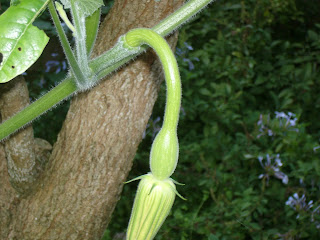 |
| Zuchini rampicante growing up and into a feijoa tree |
Long after most zuchini plants have withered up and died, the Ramicante, an Italian variety, continues to grow prolifically, though they are not forming big bottomed seed chambers on the ends as they are supposed to. That may well be their response to the lack of sun and over-abundant rainfall. The carrot seeds I sowed 2 months ago are doing well, with a fairly good strike rate. I cover my bed with shade cloth until they are big enough to withstand the birds scratching up the ground before they even emerge.
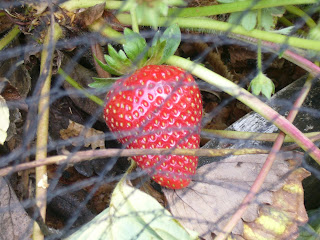 |
| Strawberries in Autumn? These strawberries are still producing..... |
 |
| Carrot bed |
 |
Self-sown New Zealand spinach self-sown under a feijoa tree
Another name is Perpetual spinach. It is considered a Heirloom
vegetable and grows as a ground cover. Perhaps because of it's
high levels of oxalic acid, slugs and snails avoid it. |
 |
| Another little pollen collector |
 |
Zuchini Rampicante hiding under the undergrowth. Note the
shrivelled seed chamber. A plight of most of my rampis this season. |
 |
| Happy little ladybird feeders |
If you want to gauge the health of one's garden, the presence of these little fellas who voraciously clean up any aphids, is a good indicator.
 |
Worm farm, with storage containers for vermicaste and comphrey
compost teas and brews |
Stepping out of the garden for a moment, I thought I could share my take on car rust. Over two years ago, I noticed several little rust spots appearing on my much-loved Toyota Corolla '85 model. My husband suggested I get them seen to. He was horrified when he discovered my rust solution. A series of car-grade sticker off-cuts my daughter procured for a school project were cut into an assortment of flowers and pasted over the rust spots. Rust? No problem. 2 years on and they sit beautifully on my car. Another advantage was that my teenage son stopped asking to borrow my car! Only trouble is, in a small town, can't travel incognito!
 |
| Answer to rust |
 |
| Bumper sticker |
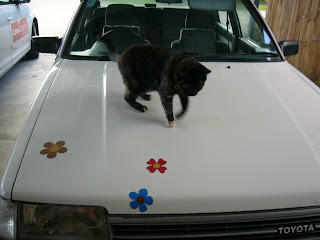 |
| Rust-proofing |
Below are images taken on my Waiora Healthy Water Workshop. The land is beautifully taken care of, and the farmer allows public access and shares it with others by allowing them to rent one of 3 little cabins built on the land, at a nominal rate. It brings to mind a quote by Rupert Stevens, a pioneering organic farmer: "Always leave the earth better than you found it."
 |
| Fluffy embankment of grasses flank the walkway into the forest |
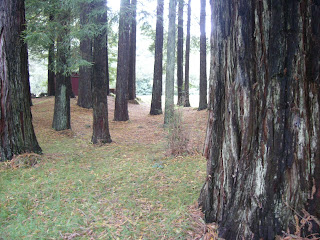 |
| Up on the hill, built amidst the tall trees, sits a little cabin for hire |
 |
| Like a scene out of Narnia |
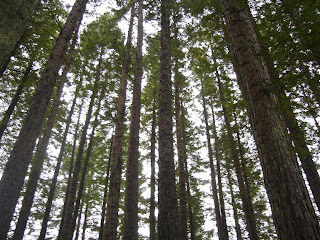 |
| I had to bend my head till it touched my shoulders to capture this shot |
 |
| Colours of Autumn cushion the forest floor |
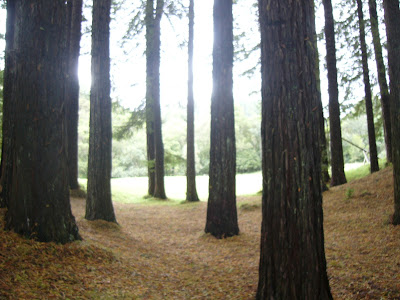 |
| Stunning natural outdoor space |